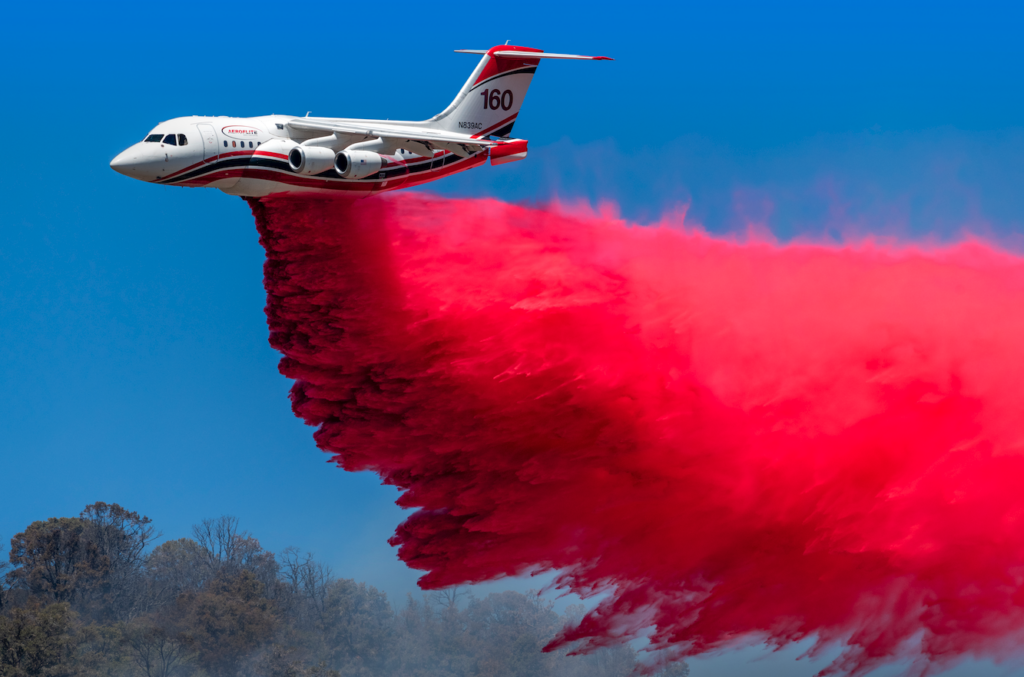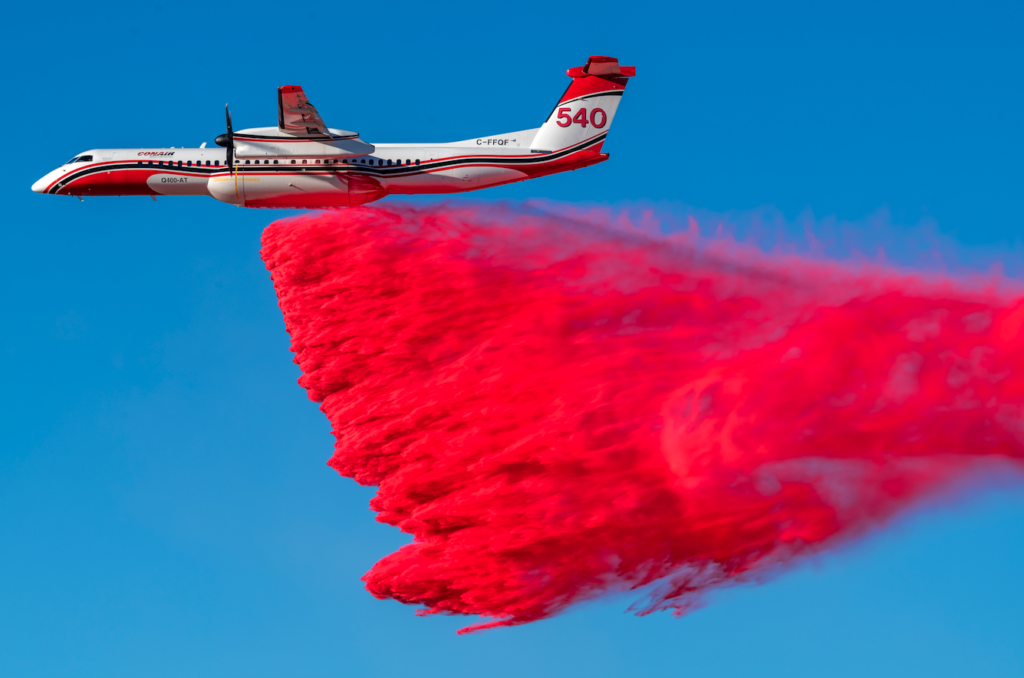By Melissa Kim, Vice President of Research & Development, Perimeter Solutions
Modern firefighting via aerial attack was first attempted in the 1920s when containers of water were dropped from planes onto active wildfires. This method presented dangers for firefighters on the ground, and future efforts similar to this were quickly abandoned. However, the promise of aerial attack was clear; the fire safety industry needed to wait for technology to catch up with their imagination.
More sophisticated attempts were introduced in the 1940s. Small planes again used water as the extinguishing agent, but using water alone made accurate application from the air difficult. Long-term fire retardants were dropped from planes a few years later to help contain and extinguish wildfires. Various active ingredients were tested, but phosphate-based PHOS-CHEK® became the first fire retardant approved by the US Forest Service (USFS) in 1963. Today phosphate-based fire retardants are used by the USFS and other fire management agencies worldwide to help contain wildfires. How did we get to this point, and why is phosphate the most common active ingredient for long-term fire retardants?

Putting Fire Retardant Chemicals to the Test
Research on the use of various chemicals as fire retardants dates back more than 80 years, with one of the earliest tests conducted at the University of Idaho in 1940. Multiple chemicals were put to the test to see which was the most effective at decreasing the combustibility of sawdust within a modified fire-tube apparatus. Evaluating a total of seven different chemicals, the researchers found that the most effective chemical, based on the loss in weight of the sample during testing, was diammonium phosphate. Filling out the rest of the list in order of effectiveness were:
- Borax
- Monoammonium phosphate
- Zinc chloride
- Ammonium sulfate
- Ammonium chloride
- Magnesium chloride
Following the test, the researchers said, “The first four were effective in moderately small amounts (8-10 percent) and may be used to fire-proof sawdust. Larger amounts of ammonium sulfate and ammonium chloride are required. In contrast, magnesium chloride is not suitable as a fire retardant.” The results from this early test would be confirmed by more sophisticated testing that would be completed in the years ahead.
What is considered to be the first major test to determine the effectiveness of various fire-retardant chemistries took place in 1954 and was conducted by the USFS. The project was called Operation Firestop, conducted at Camp Pendleton Marine Corps Base Camp. The testing was performed to determine the effectiveness of new fire attack methods from science and technology that evolved during World War II.
One phase of Operation Firestop tested the effect of fire-retardant chemicals on the ignition time of wood, the fire intensity of burning wood, and the retardant’s ability to suppress flaming wood. The study included several chemicals that had been in use over the previous years in firefighting products. The findings from Operation Firestop were clear, and they shaped the future of the retardant industry to this day. Ammonium phosphate was among the most effective chemicals in reducing fire intensity, while boric acid and magnesium chloride were among the worst. Following this groundbreaking study, phosphate-based retardants became the industry standard for decades. At the same time, boric acid, magnesium chloride, and polyvinyl acetate were discarded and not considered viable options as active ingredients for long-term retardants.
In the 1960s, firefighting communities experimented with clay and clay-like materials as a form of aerial fire retardant. These materials generally act as a water-carrying agent, which cools the fuels, raises ambient humidity, and forms a coating that inhibits the free access of oxygen and heat to the fuel and the free egress of volatile products from the fuel. Sodium calcium borate proved to be an effective fire retardant. Still, it is undesirable due to its high cost, function as a soil sterilant, inefficient dry material per gallon used, and abrasiveness to equipment.
Sixteen years after Operation Firestop, Aylmer D. Blakely, a scientist from the University of Montana, conducted additional research on fire retardant chemicals. His findings were captured in his paper, A Laboratory Method for Evaluating Forest Fire Retardant Chemicals was released in 1970. Building on the results from Operation Firestop, Blakely included additional chemicals and identified more effective parameters.
Blakely used the “superiority factor method,” a composite of various factors combined to determine the effectiveness of different chemicals. These parameters included: the rate of weight loss, remaining residue after burning, and the amount of heat radiation emitted.
The overall ranking of chemicals showed that diammonium phosphate, mono ammonium phosphate, phosphoric acid, and potassium carbonate consistently ranked higher than any other chemicals in all three parameters. Of the four chlorides tested, only magnesium chloride showed moderate effectiveness for retarding combustion within the radiation parameter.

Retardant Technology Continues to Evolve
While the studies conducted from 1940 through 1970 identified ammonium-phosphate as the most effective chemical fire retardant available, phosphate-based fire retardants continued to evolve over the years as innovations were introduced.
The first major innovation was in improving visibility for pilots. When fire retardant solutions are applied by dropping from aircraft, successive “drops” are often made by the aircraft to form a fire line. Under these circumstances, it is essential for the aircraft’s pilot to visually determine where the preceding loads were dropped. Then, the pilot can drop the load from the aircraft to form a continuation of this line. Since the fire retardant components may be colorless or may be of colors that do not contrast well with the ground or vegetation, it has been common practice to mix coloring agents with the fire retardant composition. This color provides contrast with the hue of the ground vegetation, thereby enhancing the ability of the pilot to determine where the last loads of fire retardants were dropped in constructing a fire line.
Iron oxide was one of the early coloring agents, first used in 1971 with the introduction of PHOS-CHEK 259. This fire retardant increased pilots' visibility and reduced previous technologies' corrosive properties. It is the only retardant approved for use on fixed tank helicopters containing magnesium parts highly sensitive to corrosion. The iron oxide used in this early retardant version was very colorfast. The ground and structures to which the fire retardant compositions were applied remained permanently or semi-permanently stained. Consequently, many government firefighting agencies have required that aerially applied fire retardant compositions have so-called “fugitive” coloring agents. These fugitive solutions will fade over a short time (e.g., 30 days) to a color that does not contradict the ground and vegetation. The first fugitive-colored fire retardant was introduced in 1975, providing fire management agencies the ability to effectively fight fires in aesthetically sensitive areas – such as national parks and wildland-urban interface areas – where iron oxide-colored retardants were less desirable or unacceptable.
In 1985, retardants were first introduced based on a synergistic blend of ammonium sulfate and ammonium phosphates. The new blend provided fire retardant performance similar to ammonium phosphate retardants but at a lower cost. In 1995, this phosphate/sulfate retardant blend was later eliminated in favor of a full phosphate formulation that provided more favorable environmental effects.
Firefighters must be equipped with the best tools available. Fire management agencies have used phosphate-based retardants to battle wildfires successfully for years. In contrast, independent testing has proven more effective than any other solution, including magnesium chloride. That is why we believe phosphate is used more than any other chemical ingredient for effective long-term fire retardants.






